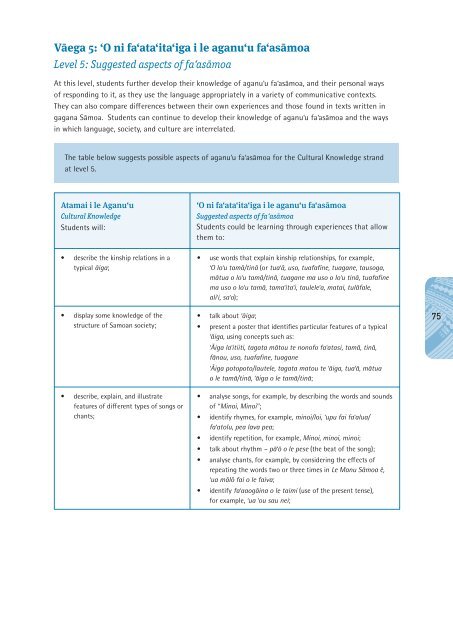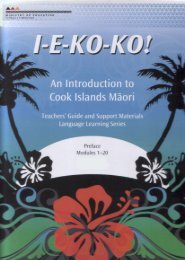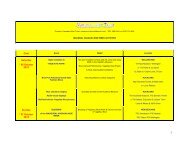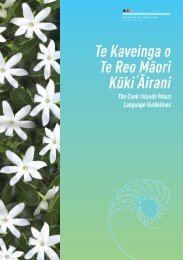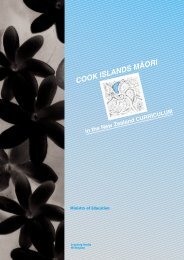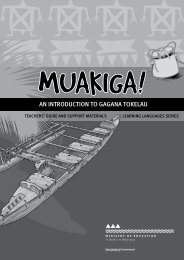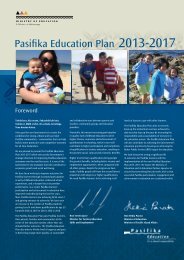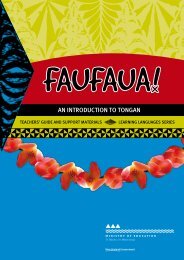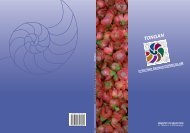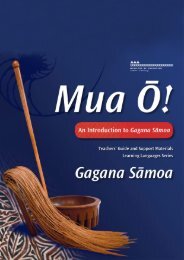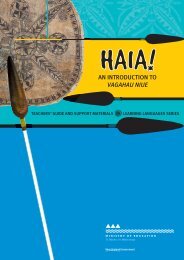Ta'iala mo le Gagana SÄmoa - Pasifika Education Community
Ta'iala mo le Gagana SÄmoa - Pasifika Education Community
Ta'iala mo le Gagana SÄmoa - Pasifika Education Community
Create successful ePaper yourself
Turn your PDF publications into a flip-book with our unique Google optimized e-Paper software.
Vāega 5: ‘O ni fa‘ata‘ita‘iga i <strong>le</strong> aganu‘u fa‘asā<strong>mo</strong>aLevel 5: Suggested aspects of fa‘asā<strong>mo</strong>aAt this <strong>le</strong>vel, students further develop their know<strong>le</strong>dge of aganu‘u fa‘asā<strong>mo</strong>a, and their personal waysof responding to it, as they use the language appropriately in a variety of communicative contexts.They can also compare differences between their own experiences and those found in texts written ingagana Sā<strong>mo</strong>a. Students can continue to develop their know<strong>le</strong>dge of aganu‘u fa‘asā<strong>mo</strong>a and the waysin which language, society, and culture are interrelated.The tab<strong>le</strong> below suggests possib<strong>le</strong> aspects of aganu‘u fa‘asā<strong>mo</strong>a for the Cultural Know<strong>le</strong>dge strandat <strong>le</strong>vel 5.Atamai i <strong>le</strong> Aganu‘uCultural Know<strong>le</strong>dgeStudents will:‘O ni fa‘ata‘ita‘iga i <strong>le</strong> aganu‘u fa‘asā<strong>mo</strong>aSuggested aspects of fa‘asā<strong>mo</strong>aStudents could be <strong>le</strong>arning through experiences that allowthem to:• describe the kinship relations in atypical āiga;• display some know<strong>le</strong>dge of thestructure of Sa<strong>mo</strong>an society;• describe, explain, and illustratefeatures of different types of songs orchants;• use words that explain kinship relationships, for examp<strong>le</strong>,‘O lo‘u tamā/tinā (or tua‘ā, uso, tuafafine, tuagane, tausoga,mātua o lo‘u tamā/tinā, tuagane ma uso o lo‘u tinā, tuafafinema uso o lo‘u tamā, tama‘ita‘i, tau<strong>le</strong><strong>le</strong>‘a, matai, tulāfa<strong>le</strong>,ali‘i, sa‘o);• talk about ‘āiga;• present a poster that identifies particular features of a typical‘āiga, using concepts such as:‘Āiga la‘itiiti, tagata mātou te nonofo fa‘atasi, tamā, tinā,fānau, uso, tuafafine, tuagane‘Āiga potopoto/laute<strong>le</strong>, tagata matou te ‘āiga, tua‘ā, mātuao <strong>le</strong> tamā/tinā, ‘āiga o <strong>le</strong> tamā/tinā;• analyse songs, for examp<strong>le</strong>, by describing the words and soundsof “Minoi, Minoi”;• identify rhymes, for examp<strong>le</strong>, minoi/loi, ‘upu fai fa‘alua/fa‘atolu, pea lava pea;• identify repetition, for examp<strong>le</strong>, Minoi, minoi, minoi;• talk about rhythm – pā‘ō o <strong>le</strong> pese (the beat of the song);• analyse chants, for examp<strong>le</strong>, by considering the effects ofrepeating the words two or three times in Le Manu Sā<strong>mo</strong>a ē,‘ua mālō fai o <strong>le</strong> faiva;• identify fa‘aaogāina o <strong>le</strong> taimi (use of the present tense),for examp<strong>le</strong>, ‘ua ‘ou sau nei;75


